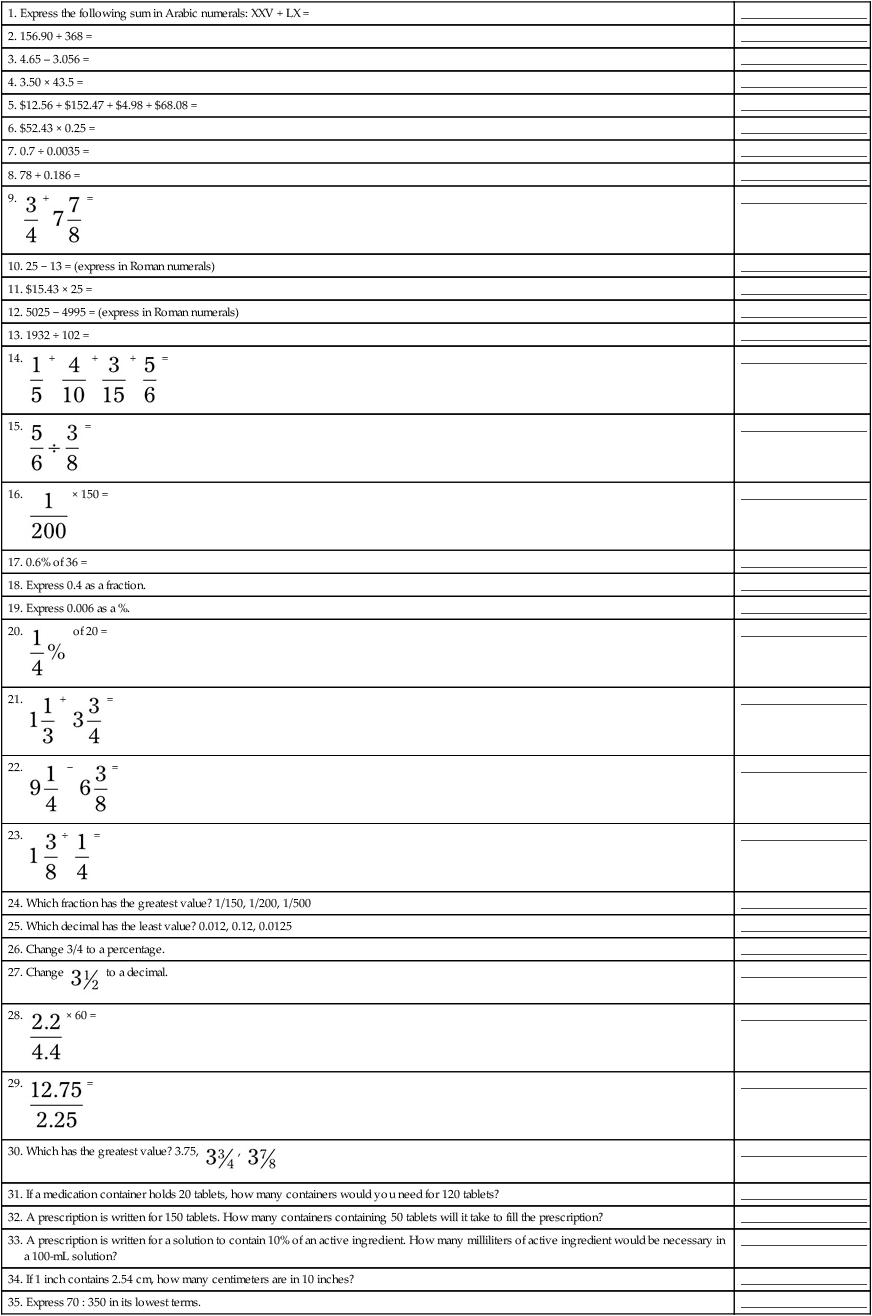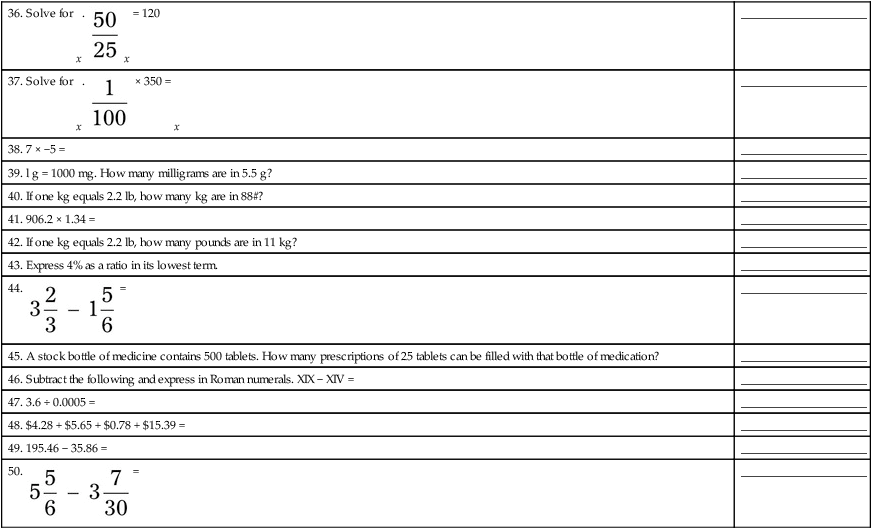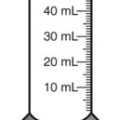Assessment of Mathematical Calculation Skills Needed for Pharmacy Technicians
• Explain why proficiency in basic mathematical skills is essential for pharmacy technicians and other health occupations
• Use medical and pharmaceutical abbreviations
• Assess basic mathematical skills needed to proficiently perform calculations in a pharmaceutical setting
Interpreting the Abbreviations Used in Medical Language
Pharmacology also has a language of its own, including shorthand, that allows physicians and other health professionals to avoid writing an entire order. Interpretation of this shorthand is a necessary component for properly dispensing prescriptions and educating patients as they take medications at home. Abbreviations are used to refer to the route or method of administration, the frequency with which a drug is to be given, and to general terms such as those found in measurement systems or those related to food and sleep. These abbreviations as well as their interpretation need to be memorized. Chapter 6 discusses using abbreviations to interpret drug orders, but learning abbreviations should start now to ensure success in interpreting orders and prescriptions later.
What Are Your Basic Math Skills?
Prerequisite skills of adding, subtracting, multiplying, and dividing whole numbers are essential before you can begin drug calculations. You must also be able to work with decimals, fractions, ratios/proportions, and percentages. Following is a self-test to be used as a tool to help you determine your math skill strengths and weaknesses. It is also an indicator of your readiness to proceed through the text. Proficiency in these basic math concepts is gauged by attaining a grade of 90% or better. In Chapter 2 you may skip basic skills in which you are proficient, but do not skip any part that gives you difficulty on this test. Having proficiency in basic math skills is of utmost importance.
General rules for taking the self-test are as follows:
• Allow yourself at least 1 hour to take the test. Each question is worth 2 points. Thus you may miss 5 questions and achieve 90%. If all the questions you miss are similar, please take time to use the materials in Chapter 2 for review of this material. In this scenario, you may pass the test yet not understand a basic math principle.
Self-Test of Proficiency in Basic Math Skills
Directions
1. Figure all decimals to three places but round answers to two places, so 1.454 would become 1.45 and 7.5685 would become 7.57.
2. Always express fractions in their lowest possible terms; for example, 4/8 should be expressed as 1/2.
3. Complete ratio and proportion problems to the lowest terms (e.g., 5 : 10 should be reduced to 1 : 2).
4. Do your work on paper, without a calculator, and keep your paperwork attached so that, if you made an error you can return to the paper and find the mistake.
Basic Math Skills Proficiency Self-Test
| 1. Express the following sum in Arabic numerals: XXV + LX = | _____________________ |
| 2. 156.90 + 368 = | _____________________ |
| 3. 4.65 – 3.056 = | _____________________ |
| 4. 3.50 × 43.5 = | _____________________ |
| 5. $12.56 + $152.47 + $4.98 + $68.08 = | _____________________ |
| 6. $52.43 × 0.25 = | _____________________ |
| 7. 0.7 ÷ 0.0035 = | _____________________ |
| 8. 78 + 0.186 = | _____________________ |
9.  + + = = |
_____________________ |
| 10. 25 − 13 = (express in Roman numerals) | _____________________ |
| 11. $15.43 × 25 = | _____________________ |
| 12. 5025 − 4995 = (express in Roman numerals) | _____________________ |
| 13. 1932 ÷ 102 = | _____________________ |
14.  + +  + + + +  = = |
_____________________ |
15.  = = |
_____________________ |
16.  × 150 = × 150 = |
_____________________ |
| 17. 0.6% of 36 = | _____________________ |
| 18. Express 0.4 as a fraction. | _____________________ |
| 19. Express 0.006 as a %. | _____________________ |
20.  of 20 = of 20 = |
_____________________ |
21.  + +  = = |
_____________________ |
22.  − −  = = |
_____________________ |
23.  ÷ ÷  = = |
_____________________ |
| 24. Which fraction has the greatest value? 1/150, 1/200, 1/500 | _____________________ |
| 25. Which decimal has the least value? 0.012, 0.12, 0.0125 | _____________________ |
| 26. Change 3/4 to a percentage. | _____________________ |
27. Change  to a decimal. to a decimal. |
_____________________ |
28.  × 60 = × 60 = |
_____________________ |
29.  = = |
_____________________ |
30. Which has the greatest value? 3.75,  , ,  |
_____________________ |
| 31. If a medication container holds 20 tablets, how many containers would you need for 120 tablets? | _____________________ |
| 32. A prescription is written for 150 tablets. How many containers containing 50 tablets will it take to fill the prescription? | _____________________ |
| 33. A prescription is written for a solution to contain 10% of an active ingredient. How many milliliters of active ingredient would be necessary in a 100-mL solution? | _____________________ |
| 34. If 1 inch contains 2.54 cm, how many centimeters are in 10 inches? | _____________________ |
| 35. Express 70 : 350 in its lowest terms. | _____________________ |
36. Solve for x.  x = 120 x = 120 |
_____________________ |
37. Solve for x.  × 350 = x × 350 = x |
_____________________ |
| 38. 7 × −5 = | _____________________ |
| 39. l g = 1000 mg. How many milligrams are in 5.5 g? | _____________________ |
| 40. If one kg equals 2.2 lb, how many kg are in 88#? | _____________________ |
| 41. 906.2 × 1.34 = | _____________________ |
| 42. If one kg equals 2.2 lb, how many pounds are in 11 kg? | _____________________ |
| 43. Express 4% as a ratio in its lowest term. | _____________________ |
44.  = = |
_____________________ |
| 45. A stock bottle of medicine contains 500 tablets. How many prescriptions of 25 tablets can be filled with that bottle of medication? | _____________________ |
| 46. Subtract the following and express in Roman numerals. XIX − XIV = | _____________________ |
| 47. 3.6 ÷ 0.0005 = | _____________________ |
| 48. $4.28 + $5.65 + $0.78 + $15.39 = | _____________________ |
| 49. 195.46 − 35.86 = | _____________________ |
50.  = = |
_____________________ |


After grading this test, look at the problems you missed. If you did not score 90% or higher, continue working on basic skills in Chapter 2. If you missed a group of problems that are related and you scored 90% or higher, review your areas of weakness. Be sure your basic mathematical skills are adequate for learning the more advanced skills that are used in pharmaceutical calculation. Self-confidence in your math skills will make learning less frustrating and calculating math fun. Be fair with yourself and spend the time necessary for basic mathematical skills.

 _____________________
_____________________ _____________________
_____________________ _____________________
_____________________ _____________________
_____________________ _____________________
_____________________ _____________________
_____________________ _____________________
_____________________ _____________________
_____________________ _____________________
_____________________ —dram
—dram —ounce
—ounce —minim
—minim —one half
—one half —with
—with —without
—without —prescription, treatment, take this drug
—prescription, treatment, take this drug —before
—before —after
—after —of each
—of each

